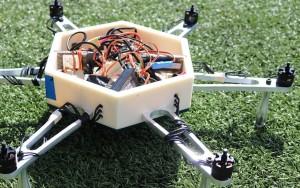
The 65 students enrolled in the course were broken into 11 teams, of which 10 had successful hexacopter launches, due largely in part to the 3D printed components of their designs. Most of those components were printed with Stratasys’ uPrint SE and Objet30 3D printers. Many of the students had already taken one of the Stratasys-created 3D printing courses offered by WIT, so were familiar with the process.
“Our design was very influenced by 3D printing,” said senior Nathan Ouellette. “It offered a unique aspect to our design, where we were able to control something in three dimensions, as opposed to just milling it in two dimensions. It offers you a whole new path to prototyping…To be able to design something and then immediately have it in front of you, you’re able to see what you did right, what you did wrong and how you can improve it – it’s something that you can’t do with most manufacturing processes, particularly with this amount of detail.”
The 3D printed components allowed the students to streamline their designs by using customized parts, eliminating the need for additional fasteners and thus making the hexacopters more lightweight.
Stratasys originally developed its “Make Something That Moves Something” curriculum in response to the growing demand for professionals with 3D printing expertise. At the rate the technology is advancing, it is increasingly important to start training college students now so that they can have a solid 3D print foundation before entering such a rapidly growing and changing industry.
“We are seeing a global arms race emerging for engineering and advanced manufacturing skills. This is requiring institutions to focus on graduating students with a full spectrum of career ready skills,” said Sig Behrens, General Manager of Global Education at Stratasys. “One key way of making this a reality is for students to engage in project based learning initiatives, like what WIT has committed to and Stratasys has supported.”
